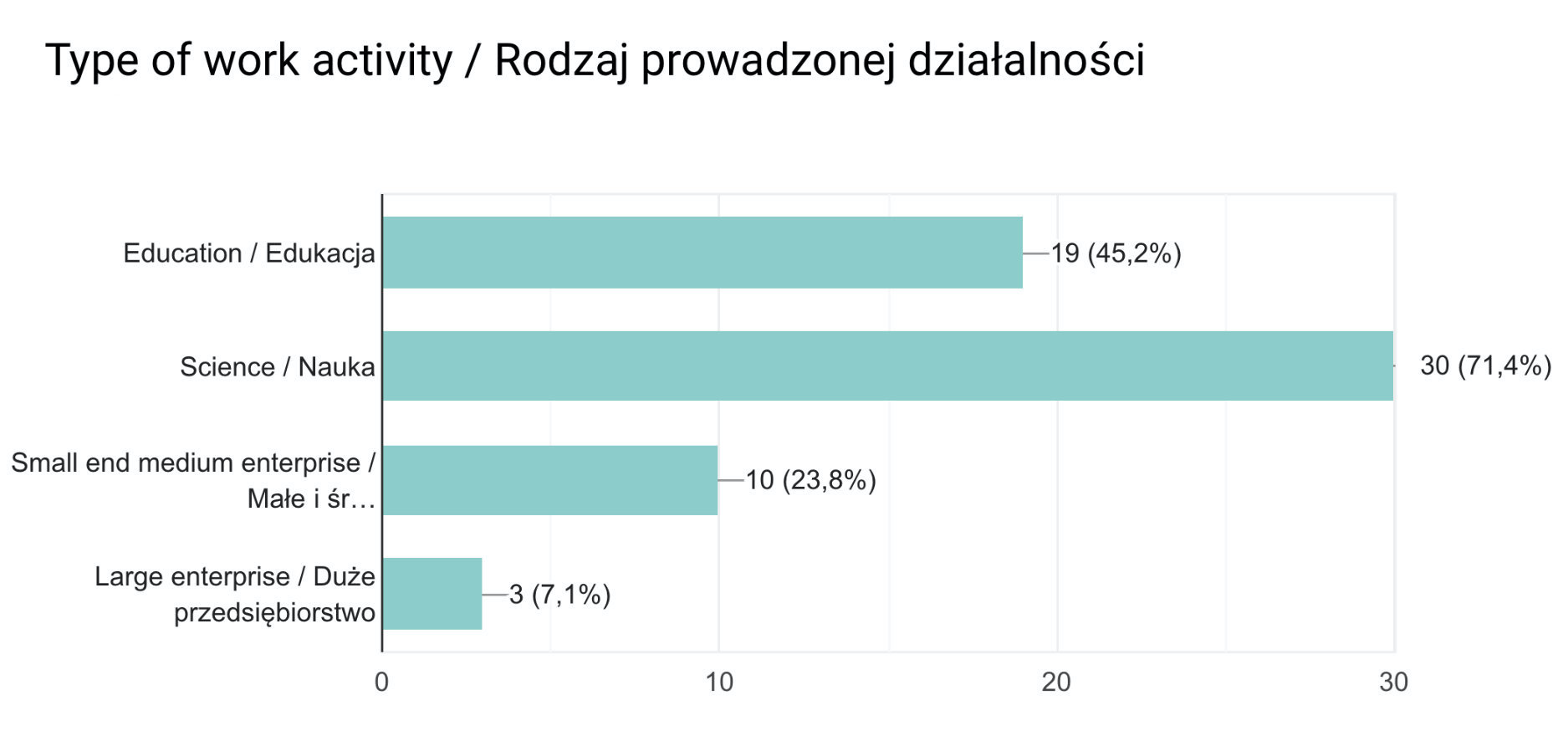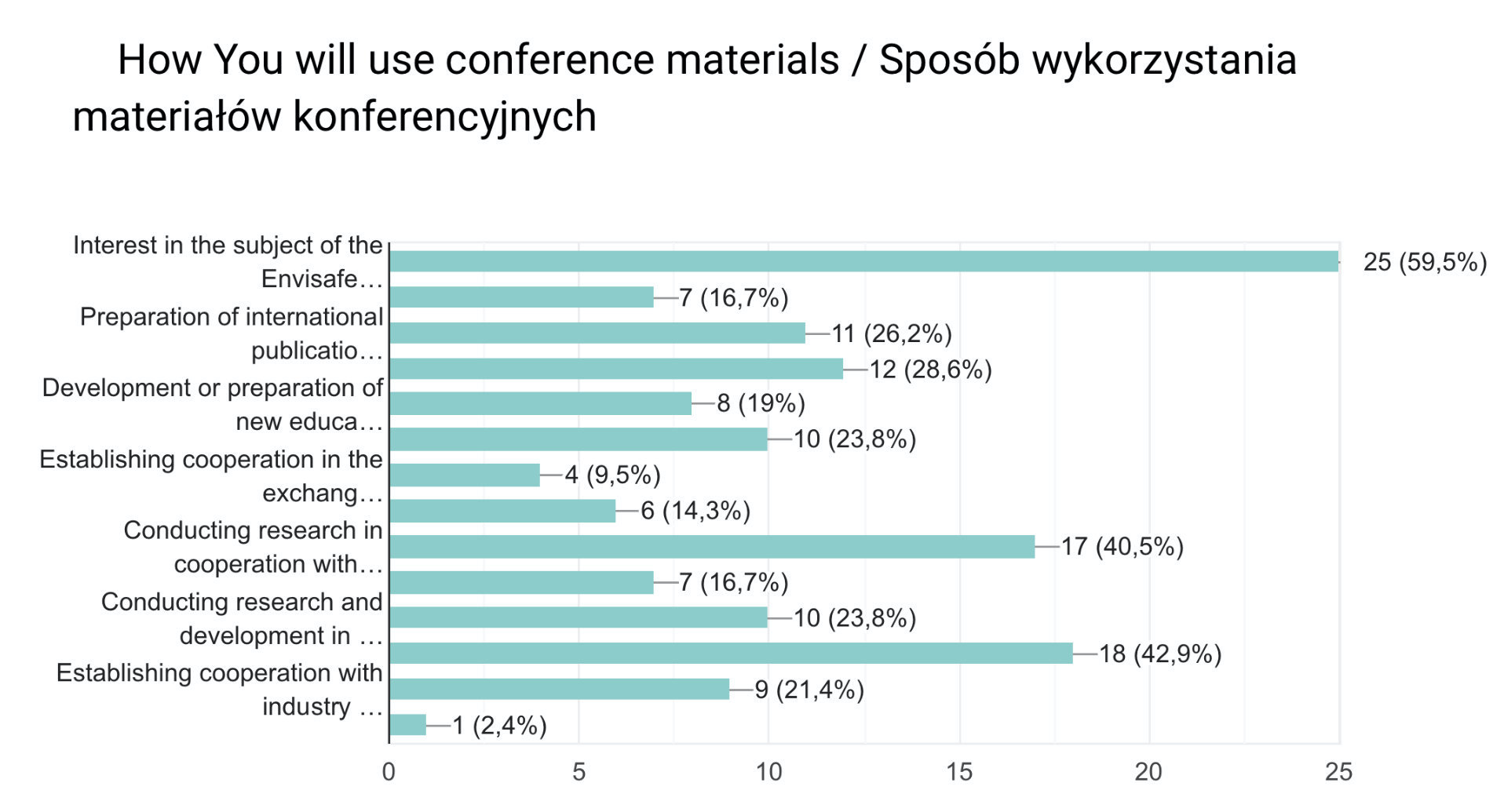W ramach aktywności w projekcie organizowana jest sesja specjalna na konferencji 14thSDEWES 2019
więcej informacji na stronie organizatora konferencji >>>> tutaj
Wyniki ankiety zainteresowania materiałami z sesji specjalnej
/raport z ankiet/
Rodzaj prowadzonej działalności
Większość respondentów zaineresowanych wynikami projektu jako główny rodzaj swojej działalności podało „naukę” (71%) , następnie „edukację” (45%), w dalszej kolejności” małe i średnie przedsiębiorstwo” (23,8%) oraz „duże przedsiębiorstwo” (7%) (Figura 1).
Respondenci ankiety zainteresowani sposobem wykorzystania materiałów konferencyjnych specjalnej sesji Environmental safety of bio-waste in the circular economy – potential for energy and matter recovery organizowanej na konferencji SDEWES2019 w ramach projektu EnvisafeBioc, wywodzą się zarówno ze świata nauki, edukacji i biznesu, co potwierdza możliwość połączenia tych trzech grup w budowaniu innowacji na poziomie światowym. Materiały z organizowanej sesji specjalnej są w obszarze zainteresowania także i przedsiębiorców, co potwierdza aktualność zagadnień poruszanych w projekcie.

Figura 1. Rodzaj prowadzonej działalności
Sposób wykorzystania materiałów konferencyjnych
Przeważająca liczba respondentów (Figura 2 )(59,5%) udzieliła odpowiedzi w zakresie A. W kolejnej grupie odpowiedzi (ok. 40%) znalazły się odpowiedzi K oraz H. Odpowiedzi w zakresie 20-28 % udzielili respondenci w zakresie zastosowań C, D, F, K oraz M. Pozostali respondenci (9,5-19 %) udzielali odpowiedzi B, E, G, H, J. Najmniej zainteresowani byli respondenci kwestiami „M. Establishing cooperation with industry aimed at adjusting the university's educational offer to market needs / Nawiązywanie współpracy z przedsiębiorcami mające na celu dostosowanie oferty edukacyjnej uczelni do potrzeb rynkowych”.
Respondenci w najmniejszym stopniu są zainteresowani ingerencją w tworzenie programów nauczania lub takich możliwości nie widzą. Wkład otoczenia gospodarczego w kwestie tworzenia programów nauczania jest dosyć nowy i wielu potencjalnych zainteresowanych nawet nie wie, że istnieją takie możliwości. Ponadto, jak wynika z ankiety zainteresowanie tematyką projektu EnvisafeBioc jest bardzo duże, co świadczy o wysokim potencjale naukowym i innowacyjnym projektu.

Figura 2. Sposób wykorzystania materiałów konferencyjnych
Materiały z sesji specjalnej do pobrania poniżej
FOTORELACJA Z WYDARZENIA

Session resume:
For many years, organic biowaste has been considered solely as a waste with no added value, land application being the most frequent and logical disposal issue for soil fertilization. However, in urban areas, or in countries with limited spreading-area or with surplus of nutrients in the soil, other ways of biowaste treatment and disposal are required. In addition to this, stricter regulation limits for organic micropollutants have been proposed and come into force in most of the EU countries, limiting and even banning land application in some regions. In conclusion, environmental European policies are pushing towards the recovery of resources from biowaste which starts to be seen as a permanent, valuable and non-transferable stock of organic resource that can be locally exploited.
The main objective of the proposed session is to discuss the most sustainable strategies for sewage sludge management, including treatment and disposal, considering the present state-of-art in terms of legislation, characterization, ecotoxicology, waste management and actual routes used currently in particular European countries. Decision making tools, namely End-of waste criteria (EWC) and Life cycle assessment (LCA) will allow to underline the importance of environmental, economic and technical evaluation of different management systems as well as the definition of the best available technologies for safe disposal and the appreciation of the eventual sludge potential ecotoxicity in long-term perspective. Nowadays, most Members apply legislation on a national level, while no integrated system for biowaste management is being used. The proposed session will help to establish criteria for best suitable option selection according to the requirements of circular economy in “from waste to resources” sense. It could also support the currently occurring amendment of the European Fertilizer Ordinance that will include organic fertilizer such as sludge, struvite, biochar, and ash-based materials.
The problem of biowaste management is currently expended widely beyond environmental engineering domain. The circular economy vision assumes a continuous positive development cycle that conserves natural capital, optimizes the use of scare resources and encourages the recycling of organic and inorganic substances. In those terms, imitating the real circular biologic cycle may facilitate the replacement of previously used linear strategy. In this context, the main aim can be reached only in the transversal interdisciplinary dimension that allows for a wide view on the life cycle of organic waste . Thus, the Session covers the following objectives :
- Assessment of the environmental impact of each biowaste management option via decision making tools e.g. Life Cycle Assessment.
- Definition of the most pertinent association of the best available technologies (BAT) for biowaste treatment and disposal that would enable local resource recovery in line with local needs, the identification of the specific assessment criteria considering BAT concept, the identification of the best performance levels and , the examination of the conditions under which these performance levels are achieved.
- Assessment of ecotoxicological impact of biowaste land application (fate of selected pollutants on the terrestrial ecosystems in short and longtime perspective).
- Comparison of different scenarios of biowaste management in relation to technological, economical and sociological aspects.
W ramach sesji zostaną zaprezentowane następujące artykuły:
- Co-treatment of Sewage Sludge with Other Organic Waste Towards the Circular Bioeconomy
Ewa Neczaj*, Anna Grosser, Anna Grobelak, Paulina Jelonek, Dorota Nowak, Piotr Celary
- The influence of grease trap sludge sterilization on performance of anaerobic co-digestion of sewage sludge
Anna Grosser*, Ewa Neczaj, Piotr Celary
- The use of life cycle assessment models to optimise biogas value chains
Kari-Anne Lyng*, Simon Saxegaar
- Intelligent facilities and sustainable development of municipal infrastructure - the circular economy concept in the water cycle and bio-waste management
Zbigniew Gieleciak, Agata Karło - Białozor, Malgorzata Kacprzak*
- The nitrogen fertilizer value of selected South African biosolids as affected by drying depth on beds
Eyob Tesfamariam*, Elvis Malobane, Craig Cogger, Ikenna Mbakwe
- Minimization of environmental risks during application of biochar with decreased quality
Jana Růžičková, Marek Kucbel*, Helena Raclavská, Barbora Švédová, Konstantin Raclavský, Dagmar Juchelkova
- Environmental risks of utilization of composts from automatic composters
Jana Růžičková, Helena Raclavská, Marek Kucbel*, Anna Grobelak, Michal Šafář, Konstantin Raclavský, Barbora Švédová, Dagmar Juchelkova
- Effect of silver nanoparticles supplied via sewage sludge on soil microbial communities
Eleonore Attard*, Pauline Courtois, Franck Vandenbulcke, Agnieszka Rorat, Claire Gassie, Marisol Goni-Urriza, Amélie Cantarel, Jonathan Gervais, Agnès Richaume, Rémy Guyoneaud
- Phytotoxicity Assay to Assess Sewage Sludge Phytoremediation Rate Using Guaiacol Peroxidase Activity (GPX): A Comparison of Four Growth Substrates
Krzysztof Fijalkowski*, Anna Kwarciak-Kozlowska, Malgorzata Kacprzak
- Ecotoxicology of silver species brought by sewage sludge in terrestrial environment
Pauline Courtois, Agnieszka Rorat, Eleonore Attard, Rémy Guyoneaud, Clément Levard, Franck Vandenbulcke*
- Solar Pyrolysis of Waste Biomass: Impact of Biomass Chemical Component Shares on Product Distribution and Gas Product Composition
Szymon Sobek*, Sebastian Werle, Łukasz Ziółkowski
- Evaluation of environmental risk of Chlorinated Organic Micropollutants in Sewage Sludge After Stabilisation Processes
Agata Rosińska*
- Changes in soil parameters and microorganisms population in the process of assisted soil phytoremediation - long term sewage sludge soil application assessment
Anna Grobelak*, Jakub Świątek, Karolina Czerwińska, Marek Kucbel, Marta Jaskulak
- Influence of sonification energy amount on sewage sludge dewatering
Paweł Wolski*, Krzysztof Fijałkowski
- Waste derived biochar as an alternative filler in biocomposites - mechanical, thermal and morphological properties of biochar added biocomposites
Agnieszka Pudełko, Przemysław Postawa, Tomasz Stachowiak, Krystyna Malińska*, Danuta Dróżdż
- Management of poultry manure in Poland – current state and future perspectives
Katarzyna Wystalska, Krystyna Malińska*, Danuta Dróżdż, Malgorzata Kacprzak, Anna Grobelak, Anna Grosser

























